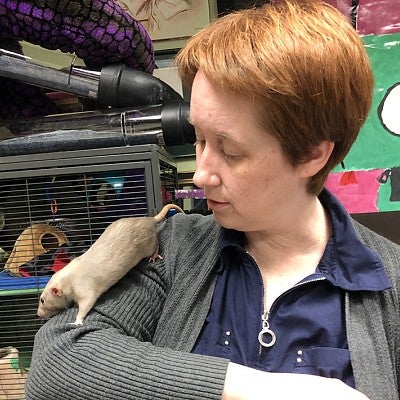Editor's Note: The gala has been rescheduled to May 2.
Brandy Todd, director of a long-running UO summer science camp for middle school girls, is always looking for ways to excite and engage young scientific minds.
So when she heard that researchers at the University of Richmond were teaching rats to drive cars, “We just knew that had to be our next project,” she said.
“One of the things that was really appealing about this is, it brings together a lot of things that are very appealing to everybody — tiny adorable little robot cars, tiny adorable little rodents,” she said.
Todd directs the Science Program to Inspire Creativity and Excellence, commonly known as SPICE, which began in 2009. The program enlists girls from sixth to ninth grades in summer camps at the UO, and to date, more than 400 girls have participated, mostly from Lane County.
SPICE camps cover a range of scientific topics, and its leaders often get asked about including robotics, which can be a problematic area for girls, Todd said.
“Lots of robotics teams are dominated by boys,” she said.
Girls sometimes get frustrated that their ideas aren’t being heard and they’re not welcomed on robotics teams, she said. That’s why the idea to teach cute rats to drive robotic cars was so attractive.
SPICE plans to launch a Robo Rat Rally competition in the fall, for girls and boys. Teams will develop skills in neuroscience, robotics, animal husbandry and project management as they design and build their own ROVs — rodent-operated vehicles — and train their rodent partners to navigate courses and overcome obstacles in their little cars.
To generate interest, and cash, for the program, SPICE is hosting a fundraiser gala May 2. Guests will get to see SPICE girls demonstrating science principles using fire, explosions, cryogenic fluids and energetic chemical reactions. The night will be capped off with a Robo Rat Rally, with rat pilots competing in a racing tournament.

“How are you going to get that up there? You’ve bitten off way more than you can chew. You’re going to get that stuck sideways in the tube,” she told Jane.
After not getting stuck and stashing the cracker in her cage, Jane returned to climb in one of the robotic cars on Todd’s desk, hoping for a reward.
Todd buys the robotic cars from Amazon. They’re “smart” cars, programmed to follow a line on the ground and avoid obstacles, “but we want the rats to be the brain so we strip all that out,” Todd said. Three inputs are added to the processor: forward, right turn, left turn.
An aluminum contact plate is installed on the floor of the car, and copper wire is attached to the front and the sides of the cockpit. When the rats have their back paws on the plate and touch one of the wires with their front paws, they complete the circuit and cause the car to move.
Training rats to drive is not as difficult as it sounds, in part because they as smart as most dogs, Todd said.
“It all starts with training the rats through a series of simple tasks: Come to the car, get a reward. Get in the car, get a reward. Put your paw on the wire, get a reward,” she said.
Once the rats learn the basics of driving the car, it becomes harder for them to earn a treat.
“They have to use what they’ve learned to solve a problem or get around an obstacle” to earn a reward, she said.
“It has mechanical and biological and intellectual components,” she said. “You have to figure out when the rat has been training you.”
Each team in the fall program will have to adopt at least two rats and go through a series of workshops on rat care, and sign a contract committing to care for the animals for the rest of the animals’ lives.
One interesting finding from the University of Richmond study is that rats who drove cars experienced decreased stress compared to rats who were just driven around.
Just as humans seek out cognitively challenging activities, such as working a crossword puzzle or navigating a climbing wall, Todd said, so do the rats. And because rats are serving as proxies for humans in these studies, “we need to stimulate them,” she said.
“We should put them in an environment that maximizes their cognitive abilities and happiness,” she said.
—By Tim Christie, University Communications

